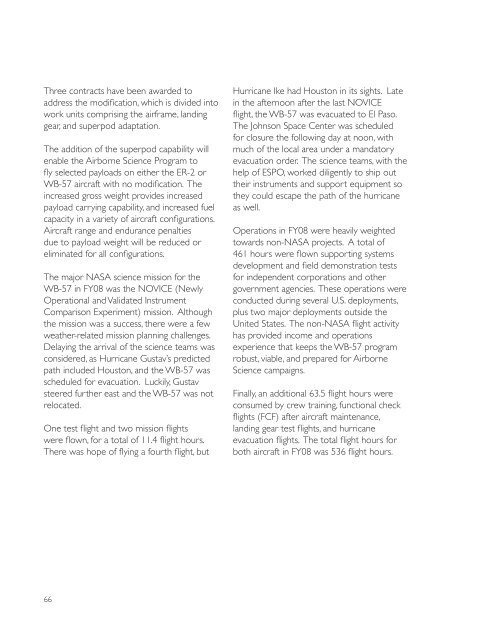2008 Annual Report - NASA Airborne Science Program
2008 Annual Report - NASA Airborne Science Program
2008 Annual Report - NASA Airborne Science Program
You also want an ePaper? Increase the reach of your titles
YUMPU automatically turns print PDFs into web optimized ePapers that Google loves.
Three contracts have been awarded to<br />
address the modification, which is divided into<br />
work units comprising the airframe, landing<br />
gear, and superpod adaptation.<br />
The addition of the superpod capability will<br />
enable the <strong>Airborne</strong> <strong>Science</strong> <strong>Program</strong> to<br />
fly selected payloads on either the ER-2 or<br />
WB-57 aircraft with no modification. The<br />
increased gross weight provides increased<br />
payload carrying capability, and increased fuel<br />
capacity in a variety of aircraft configurations.<br />
Aircraft range and endurance penalties<br />
due to payload weight will be reduced or<br />
eliminated for all configurations.<br />
The major <strong>NASA</strong> science mission for the<br />
WB-57 in FY08 was the NOVICE (Newly<br />
Operational and Validated Instrument<br />
Comparison Experiment) mission. Although<br />
the mission was a success, there were a few<br />
weather-related mission planning challenges.<br />
Delaying the arrival of the science teams was<br />
considered, as Hurricane Gustav’s predicted<br />
path included Houston, and the WB-57 was<br />
scheduled for evacuation. Luckily, Gustav<br />
steered further east and the WB-57 was not<br />
relocated.<br />
One test flight and two mission flights<br />
were flown, for a total of 11.4 flight hours.<br />
There was hope of flying a fourth flight, but<br />
Hurricane Ike had Houston in its sights. Late<br />
in the afternoon after the last NOVICE<br />
flight, the WB-57 was evacuated to El Paso.<br />
The Johnson Space Center was scheduled<br />
for closure the following day at noon, with<br />
much of the local area under a mandatory<br />
evacuation order. The science teams, with the<br />
help of ESPO, worked diligently to ship out<br />
their instruments and support equipment so<br />
they could escape the path of the hurricane<br />
as well.<br />
Operations in FY08 were heavily weighted<br />
towards non-<strong>NASA</strong> projects. A total of<br />
461 hours were flown supporting systems<br />
development and field demonstration tests<br />
for independent corporations and other<br />
government agencies. These operations were<br />
conducted during several U.S. deployments,<br />
plus two major deployments outside the<br />
United States. The non-<strong>NASA</strong> flight activity<br />
has provided income and operations<br />
experience that keeps the WB-57 program<br />
robust, viable, and prepared for <strong>Airborne</strong><br />
<strong>Science</strong> campaigns.<br />
Finally, an additional 63.5 flight hours were<br />
consumed by crew training, functional check<br />
flights (FCF) after aircraft maintenance,<br />
landing gear test flights, and hurricane<br />
evacuation flights. The total flight hours for<br />
both aircraft in FY08 was 536 flight hours.<br />
66











